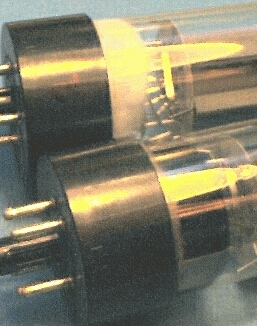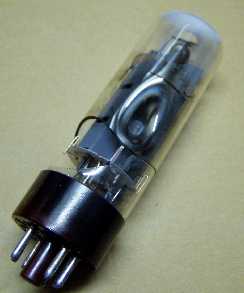Valve abuse
Some valves die of old age, others are killed off prematurely.
Contains:
Normal life
Being glass we might expect that most valves fail by getting broken. While this certainly happens, the majority of valves I replace are because of electrical failure.
Soft or gassy valves are a rarity these days thanks to modern out-gassing techniques, so the vast majority fail due to loss of cathode emission.

Unhealthy blue glow
The cathode is coated with compounds containing thorium, strontium and barium oxides which are good electron emitters at low temperatures (~800°C).
The properties that make these good cathode materials make them very dangerous materials to ingest.
Most of the dust inside a broken valve is magnesium oxide used to insulate the heater from the cathode, but some of it will be cathode material which may be radioactive and should be treated as highly toxic.
Thorium has been widely used and, like plutonium, is an alpha and beta emitter with a half-life if 1010 years. Mercury-vapour tubes (including fluro lighting tubes) only add another toxin. You certainly don't want to breathe any into your lungs.
These cathode materials work over time and lose electron emission. The more current they are expected to carry, the quicker they lose emission. This is the dominant failure mode.
The cathodes in power valves get worked very hard so they need to be replaced every year or so. Preamp valves get a very easy time of it and I've just had an amp through with some 12AX7's date-coded 1965 that are still going just fine. Preamps typically die by going microphonic.
Flashover
This is from an amp run without a load. The anode pin has flashed over to one of the heater pins and carbonised a track into the base phenolic.
This causes an arc which is bright white but almost silent. There is a smell of burning bakelite. If sustained it will damage the power supply. This incident also wrote off the output transformer.
The track is burned deep into the base material and cannot be recovered by attempting to open the carbon path.
Loss of vacuume
The silver layer seen on the inside of a valves glass is the getter. This mops up residual oxygen in the valve after it is sealed, for the life of the valve.
“To remove the last traces of free gas, a little barium or magnesium is usually evaporated within the envelope just before sealing. The getter, as this material is called, is fired by means of high-frequency eddy currents, and after evaporation condenses on the envelope near the getter-holder, a small metal holder welded to the electrode assembly.”
- J.P. “Pat” Hawker, Radio and Television Engineers Reference Book, Newnes 1960.
Sometimes tiny pockets of gas are caught in the structure during manufacture, and elements can outgas, particularly if overheated during overload. The getter is supposed to mop these up by forming an oxide of the getter material.
If the valve gets a gross leak, generally around a wire lead-in, or is cracked or broken admitting air, the getter changes colour from silver to a milky white.

The 6L6 in front still has a hard vacuume. The one at rear seems physically intact but has a broken base seal. Note the colour of the getters just above the base. If you burned a bit of magnesium at school you may remember the oxide is white.
Meltdown
Like a FET, a valve is in a conducting state until it is biassed off.
With preamp valves this bias comes from the cathode resistor. This resistor is generally bypassed with a small electrolytic cap, traditionally 25uF/25V. These are lightly stressed so it is uncommon for them to fail short circuit. Even if one did the anode resistor of 100-220k keeps things in check.
The reverb line driver is a bit different, and if its cathode bypass goes short most of the HT will be impressed across the coupling transformer, doing it no good at all.
It's in the power stages that a loss of bias has the biggest impact. If the bias supply should fail then both (or all four) output valves will try to conduct to their fullest. This can also arise if the grid structure has been damaged by vibration or impact, and lost control of the electron stream.
When a valve tries to short a guitar amp power supply it is normally the valve that comes off second best. The power supply has more capacity to deliver watts than the valve has the ability to get rid of, and melts.

Source: Rockinghouse
Bias failure under drive can lead to a valve glass simply cracking with the sudden thermal shock of a white-hot anode nearby.
Hard driving, particularly with the bias set a bit low, leads to glowing anodes and the nearby glass softening, which is then deformed inward by air pressure. As this puts it closer to the hot anode a slow thermal runaway results, with the air finally punching through the middle of the soft spot and a resulting fireworks display.
“How hot should anodes get?”
Manufacturerers don't intend the anodes of any of this class of valve to glow red-hot at rated power. Any red glow in the anodes suggests the valves are being driven a bit hard, a modulated bright red glow even moreso. In extreme cases you can see the shadow of the grid imaged in the glow.
Excessive heating means the cathode is being worked too hard and the valve will quickly lose emission, but it also risks outgassing, releasing trapped pockets of gas within the structure that will also quickly poison (make inactive) the cathode surface material due to ion bombardment.
Some valve types are more tolerant to being over-driven than others. The maximum ratings of all valves should be taken seriously, but particularly 6CA7/EL34's. These don't seem to have much reserve on their screen dissipation rating and I've seen screen grids lighting up within the structure. Grids are not designed to light up! If you can see a grid glowing, following the signal, you are only one shaved inch from a major meltdown.
 <<<OzValveAmps
<<<OzValveAmps
http://www.ozvalveamps.org/valveabuse.html | Last update:
22:11 24/09/05
|



